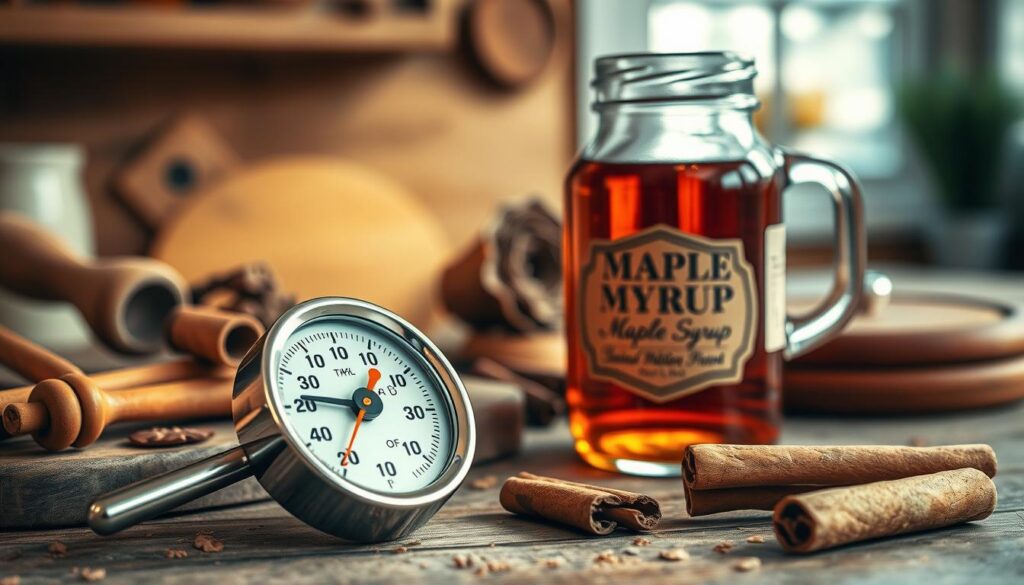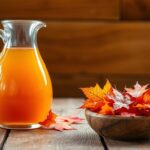Making perfect maple syrup is an art that needs precision. Your journey to creating liquid gold starts with a key tool: the maple syrup thermometer. Both professional sugarmakers and home enthusiasts know that controlling temperature is key. It turns ordinary sap into a delicious, rich syrup that pleases the taste buds.
Every drop of maple syrup has a story of careful temperature management. Sugarmakers tap maple trees during a short season. They use a precise maple syrup thermometer to get the essence of this natural sweetener. The difference between great and ordinary syrup is just a few degrees.
Temperature is more than a number—it’s the secret to unlocking maple sap’s complex flavors. Your thermometer is key in turning raw sap into a smooth, amber syrup. This syrup captures the essence of North American forests.
Whether you’re experienced or just starting, knowing how to use a maple syrup thermometer can improve your skills. This essential tool helps bridge the gap between amateur and professional syrup-making. It ensures consistent quality with every batch.
As you explore maple syrup production, you’ll see that the right thermometer is more than a tool. It’s your guide to creating liquid perfection. This captures the true spirit of this honored tradition.
Understanding the Importance of Temperature in Maple Syrup Making
Making perfect maple syrup is more than just collecting sap. Temperature is key to turning raw sap into a tasty golden syrup. You need the right maple syrup making equipment, like an accurate thermometer, to get it just right.
The process from sap to syrup is very scientific. Maple sap has 2-3% sugar, which affects its boiling point and quality. Sugarmakers must track temperature closely for consistent syrup.
The Science Behind Maple Syrup Consistency
Knowing the sugar content is vital in making maple syrup. The Rule of 86 helps producers figure out how much sap is needed for syrup:
- 1% sugar content requires 86 gallons of sap
- 2% sugar content requires 43 gallons of sap
- 3% sugar content requires 28.6 gallons of sap
Critical Temperature Points for Perfect Syrup
| Sugar Content | Boiling Point | Syrup Consistency |
|---|---|---|
| 2% Sugar | 212°F | Thin Syrup |
| 3% Sugar | 219°F | Medium Syrup |
| 4% Sugar | 224°F | Thick Syrup |
Why Temperature Precision Matters
An accurate maple syrup thermometer is essential. It can make a big difference between a top-grade syrup and a lower quality one. Digital thermometers with ±0.1°F accuracy help sugarmakers make syrup consistently.
What is a Maple Syrup Thermometer and How Does it Work
A maple syrup thermometer is a special tool for making syrup. It’s not like the thermometers you find in kitchens. This tool helps track important temperature changes during syrup making.
This thermometer is key for making syrup. It does several important things:
- Measures temperatures between 210°F and 250°F with extreme accuracy
- Withstands high heat and sugar concentration
- Provides real-time temperature readings during boiling
- Helps prevent burning or under-processing of maple syrup
Maple syrup thermometers come in two main types: digital and analog. Digital ones give quick, precise readings on an electronic screen. Analog models use mercury or alcohol and are more traditional. Each type has its own benefits for different syrup-making scales.
The main job of a maple syrup thermometer is to track when sap turns into syrup. It needs to measure tiny temperature changes to know when the syrup is just right.
“Temperature is the silent conductor of maple syrup perfection” – Traditional Sugarmaker’s Wisdom
Professional sugarmakers use these thermometers to make sure their syrup is always top quality. They turn raw maple sap into golden syrup by controlling the temperature carefully.
Types of Maple Syrup Thermometers Available Today
Choosing the right maple syrup thermometer can really boost your syrup quality. Today’s tech gives sugarmakers many ways to track temperature accurately and easily.
Maple syrup making needs precise temperature control. There are thermometers for every scale and taste.
Digital Maple Syrup Thermometers: Precision Technology
Digital thermometers lead in temperature tracking. They offer:
- Instant temperature readings
- High accuracy within 0.1 degree
- Digital displays for easy reading
- Optional wireless connectivity
Analog Thermometers: Traditional Production Methods
Analog thermometers are loved by seasoned sugarmakers. They value traditional methods. These thermometers provide:
- Mechanical reliability
- No battery requirements
- Durability in harsh conditions
- Simple calibration process
Specialty Hybrid Models: Bridging Traditional and Modern
Hybrid thermometers mix digital precision with classic design. They give sugarmakers the best of both worlds. They blend modern tech with traditional syrup making.
“The right thermometer transforms maple syrup production from guesswork to scientific precision.” – Maple Production Experts
Key Features to Look for in a Reliable Maple Syrup Thermometer
Choosing a top-rated maple syrup thermometer is important. It’s key for sugarmakers and home enthusiasts who want precise syrup. A good thermometer helps in making syrup accurately.
Experts say to look for certain features in a temperature measuring device. These features ensure accurate and consistent results.
- Temperature Range: Critical for capturing precise syrup-making stages
- Accuracy within ±1 degree Fahrenheit
- Quick response time
- Durable construction
- Easy-to-read display
A top-rated maple syrup thermometer must be tough and show clear readings. Both digital and analog models have their own benefits for different needs.
| Feature | Digital Thermometer | Analog Thermometer |
|---|---|---|
| Accuracy | ±0.5-1°F | ±1-2°F |
| Durability | High | Medium |
| Price Range | $50-$200 | $20-$80 |
Professional sugarmakers look for waterproof design and calibration. These features make a thermometer stand out from kitchen tools.
The right thermometer transforms maple syrup production from guesswork to precise craftsmanship.
Invest in a quality thermometer. It will give you consistent, dependable temperature readings for your maple syrup-making.
Top-Rated Maple Syrup Thermometers for Home Use
Choosing the right maple syrup thermometer can make a big difference. It can turn your syrup-making into a top-notch experience. Whether you’re new or have been making syrup for years, the right tool is key to perfect syrup.
When picking a thermometer, think about what you need and how much you want to spend. There are many options out there. They’re all designed to help you make syrup that’s just right.
Professional-Grade Options
Professional-grade thermometers are top-notch. They’re built for serious syrup makers. These tools give you accurate temperature readings every time.
- Digital precision models with instant readout
- Stainless steel construction
- Advanced temperature range capabilities
Budget-Friendly Choices
You don’t have to spend a lot to get a good thermometer. There are affordable options that work great for home use.
| Thermometer Type | Price Range | Accuracy |
|---|---|---|
| Basic Digital | $15-$30 | ±1°F |
| Analog Probe | $10-$25 | ±2°F |
Premium Selection
If you’re looking for the best maple syrup thermometer, premium models are the way to go. They offer amazing features and accuracy.
- Bluetooth connectivity
- Multiple temperature sensors
- Extended warranty options
Getting a good thermometer means your syrup will always taste great. It’s an investment in your syrup-making skills.
How to Calibrate Your Maple Syrup Thermometer
Keeping your maple syrup thermometer accurate is key for top-notch syrup. Calibration makes sure your thermometer gives exact temperatures. This is vital for syrup-making.
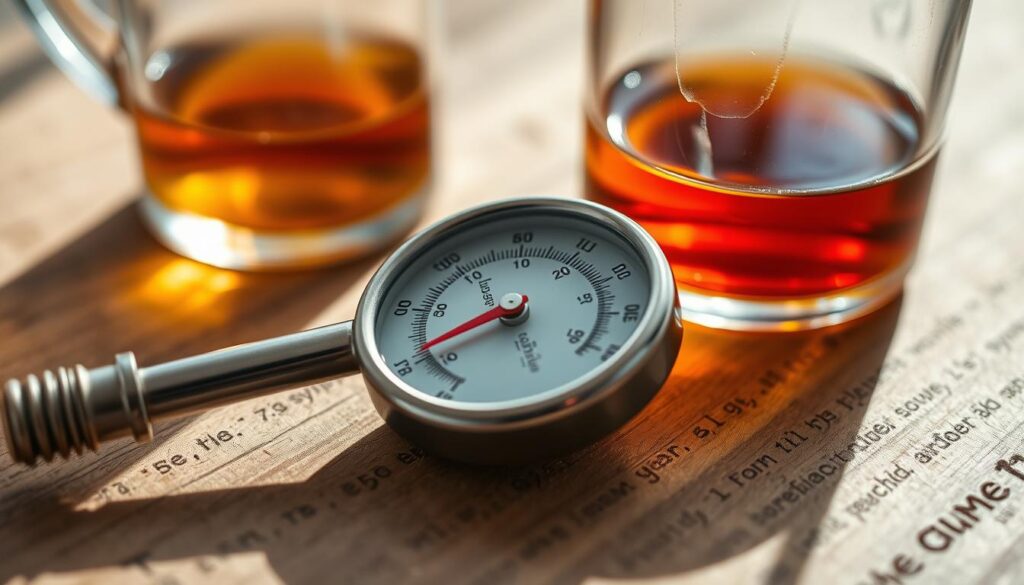
Experts in sugarmaking know that precise temperatures are essential. A thermometer that’s not calibrated can ruin the syrup. It can make the syrup taste bad or not be the right consistency.
Calibration Methods
- Ice Bath Test
- Boiling Water Test
- Precision Comparison Method
Ice Bath Calibration Step-by-Step
- Fill a glass with crushed ice and water
- Insert the maple syrup thermometer into the mixture
- Verify the reading is exactly 32°F (0°C)
- Adjust the thermometer if necessary
Boiling Water Calibration
The boiling water test checks if your thermometer is right for high temperatures. Boil water and see if it shows 212°F (100°C) at your altitude.
| Calibration Method | Temperature Check Point | Recommended Frequency |
|---|---|---|
| Ice Bath Test | 32°F (0°C) | Before syrup season |
| Boiling Water Test | 212°F (100°C) | Annually |
| Precision Comparison | Multiple Points | Every 2-3 years |
Pro tip: Always handle your maple syrup thermometer with care to maintain its accuracy and longevity.
Temperature Ranges and Optimal Settings for Perfect Syrup
Making maple syrup is all about precision. The right temperature is key to quality and grade. Knowing the best temperature ranges helps make syrup that meets high standards.
Each temperature brings out different flavors in syrup. A good thermometer is vital for this process. It helps monitor temperature to get the perfect syrup.
Syrup Grades and Their Temperature Requirements
Maple syrup grades depend on temperature control:
- Golden Color, Delicate Taste: Needs a lower temperature (around 219-221°F)
- Amber Color, Rich Flavor: Mid-range temperatures (221-224°F)
- Dark Color, Robust Taste: Higher temperatures (224-228°F)
Altitude Variations and Temperature Adjustments
Altitude affects boiling points for maple syrup. As you go higher, the boiling point goes down. Sugarmakers need to adjust their equipment for these changes.
Pro tip: For every 500 feet above sea level, subtract 1 degree from the standard boiling point.
Getting the temperature right ensures syrup quality. It turns sap into a tasty treat.
Common Mistakes When Using a Maple Syrup Thermometer
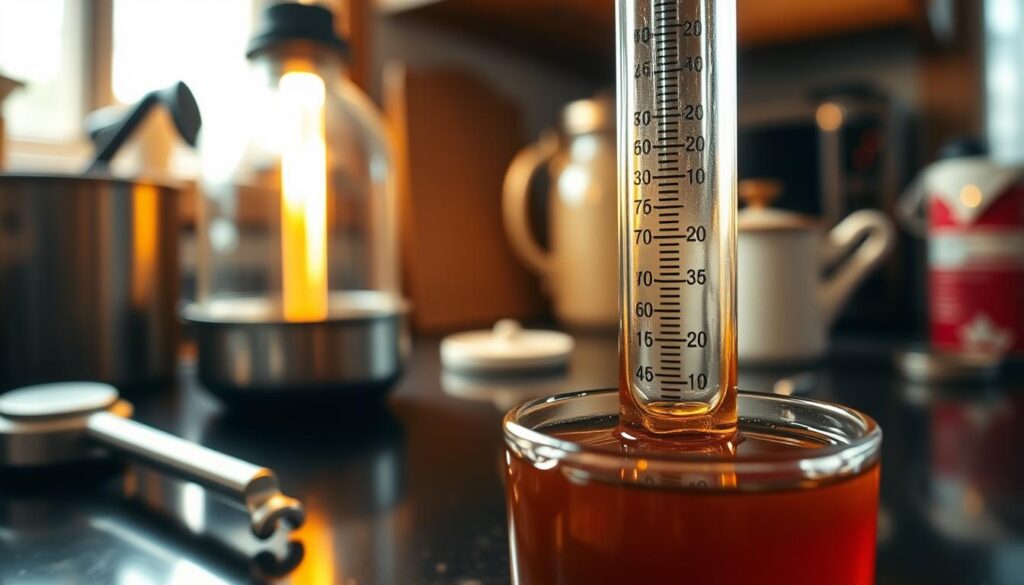
Making perfect maple syrup needs precision. An accurate maple syrup thermometer is key. Even experienced sugarmakers can make mistakes that affect their readings.
New maple syrup makers often make a few big mistakes:
- Improper thermometer placement in the boiling pan
- Neglecting steam interference during temperature measurement
- Misreading analog scale markings
- Failing to calibrate the thermometer regularly
One big mistake is putting the thermometer in the wrong spot. Where you place the thermometer affects how accurate it is. It’s important to make sure the sensor is in the middle of the liquid. Avoid touching the sides or bottom of the pan, as this can mess up the reading.
Steam is another big problem. It can block the view of the thermometer, leading to wrong readings. To avoid this, use a thermometer with a shield or manage the steam carefully.
Analog thermometers can be tricky. Small mistakes in reading the scale can lead to big differences in syrup quality. Digital thermometers are more accurate, helping to avoid mistakes.
Precision is the secret ingredient in creating exceptional maple syrup.
Keeping your thermometer accurate is very important. Check it regularly and have it professionally calibrated. This helps avoid long-term mistakes that can ruin your syrup’s quality.
Maintenance and Care Tips for Long-lasting Performance
Keeping your maple syrup thermometer in good shape is key for accurate readings. Proper care helps your equipment last longer and work better. This is important for making maple syrup.
Looking after precision tools is important. Sugarmakers spend a lot of time and money on their gear. So, keeping it in good condition is vital for making maple syrup.
Essential Cleaning Techniques
Cleaning your thermometer needs to be gentle but thorough. Here’s how to do it right:
- Rinse it with warm water right after use
- Use mild dish soap for tough spots
- Stay away from rough stuff that can hurt the sensors
- Wipe it dry with a soft, lint-free cloth
“A clean thermometer is a reliable thermometer” – Maple Syrup Artisans Association
Strategic Storage Recommendations
Storing your equipment right is important, even when you’re not using it. Here are some tips:
- Keep it in a cool, dry spot
- Use protective cases for digital thermometers
- Don’t let it get too much sunlight
- Try to keep the temperature steady
Digital and analog thermometers need different storage to keep working well.
Digital vs. Traditional: Which Maple Syrup Thermometer is Right for You
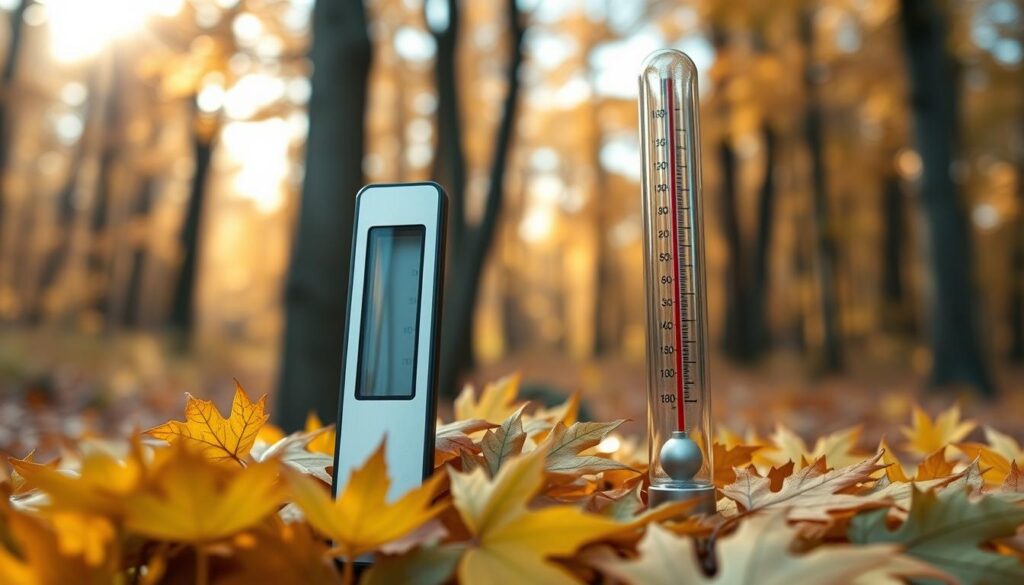
Choosing the right maple syrup thermometer is key to making great syrup. Both digital and traditional thermometers have their own benefits for sugarmakers.
Digital maple syrup thermometers offer several advantages:
- Precise digital readings with high accuracy
- Easy-to-read LCD displays
- Quick temperature response times
- Some models with wireless connectivity
Traditional analog thermometers also have their strengths:
- Reliable mechanical design
- No battery requirements
- Lower initial cost
- Durable construction for long-term use
Think about what you need when picking a thermometer. Professionals might like digital for its advanced features. Hobbyists might prefer analog for its simplicity.
Pro tip: Make sure your thermometer can handle high temperatures and gives consistent readings during syrup making.
The right thermometer transforms good maple syrup into exceptional maple syrup.
Professional Tips for Accurate Temperature Reading
Getting the right temperature is key to making great maple syrup. An accurate thermometer can turn a good batch into an excellent one. Sugarmakers know that getting the temperature right needs skill and focus.
Learning to read temperatures well is about using the right strategies. These can greatly improve your thermometer’s accuracy.
Strategic Thermometer Placement
Where you put your thermometer affects how accurate your reading will be. Here are some important tips:
- Put the thermometer in the center of the boiling pan
- Don’t let it touch the bottom or sides of the pan
- Make sure the tip is fully in the sap
- Keep it away from the flame or heat
Timing Your Temperature Measurements
Knowing when to take temperature readings is vital for making syrup. Sugarmakers suggest these timing tips:
- Wait until the sap boils steadily
- Take readings often, at short intervals
- Wait 30-60 seconds between readings for stable numbers
- Keep track of temperature changes
| Syrup Stage | Temperature Range | Reading Frequency |
|---|---|---|
| Initial Boiling | 212-215°F | Every 2-3 minutes |
| Syrup Formation | 219-221°F | Every 1-2 minutes |
| Final Stage | 224°F | Continuous monitoring |
By using these professional tips, syrup lovers can get better at using their thermometer. Remember, practice and patience are essential for mastering temperature readings.
Troubleshooting Common Temperature Reading Issues
Maple syrup making needs to be precise. A good maple syrup thermometer is key for perfect syrup. But, sugarmakers often face problems that can mess up the temperature reading.
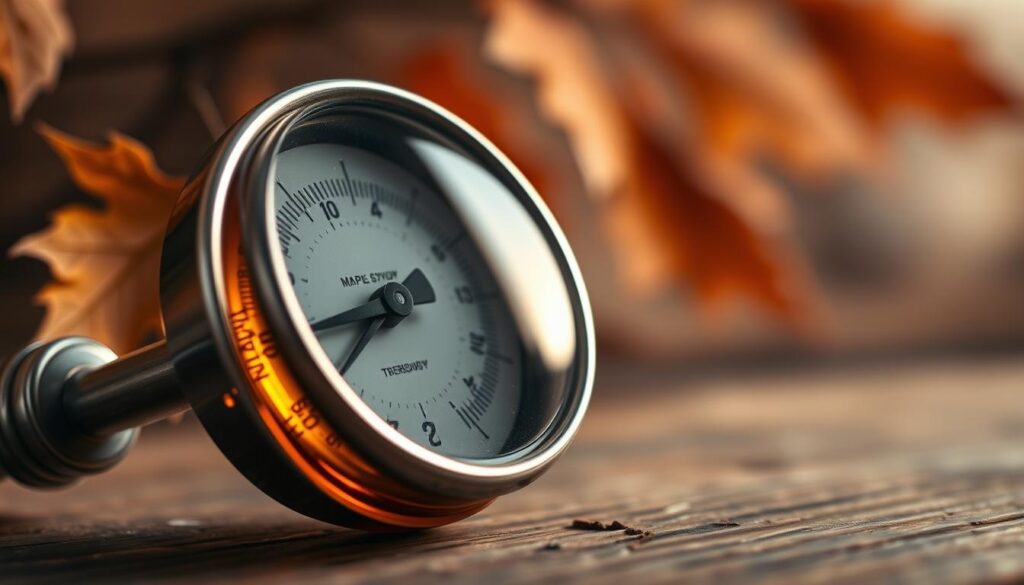
Fixing common temperature issues can save time and protect your syrup making investment. Here are some tips for your thermometer:
- Check for visible damage like cracks or bent probes
- Verify calibration accuracy at regular intervals
- Clean thermometer thoroughly between uses
- Ensure proper storage to prevent moisture damage
Digital thermometers have their own problems. Bad batteries can mess up readings, so change them often. For analog thermometers, look for corrosion or wear on metal parts that could affect accuracy.
| Issue | Potential Cause | Recommended Solution |
|---|---|---|
| Slow Response Time | Sensor degradation | Replace thermometer probe |
| Inconsistent Readings | Calibration drift | Recalibrate or replace device |
| Electronic Malfunction | Battery or circuit issue | Check battery, contact manufacturer |
Experts suggest having a backup thermometer for important syrup making stages. Quick fixes can avoid big losses in your syrup making.
Where to Buy Quality Maple Syrup Thermometers
Finding the right maple syrup thermometer is key for both pros and hobbyists. The market has many options to fit different needs and budgets.
Choosing the right place to buy your top-rated maple syrup thermometer is important. You need to think about a few things:
- Reliability of the seller
- Product warranty
- Customer support
- Price competitiveness
Online Retailers
Digital marketplaces make buying maple syrup thermometers easy. Sites like eBay offer specialized equipment. They have detailed descriptions and reviews to help you choose.
| Online Platform | Pros | Price Range |
|---|---|---|
| Amazon | Wide selection, fast shipping | $20-$150 |
| Specialty Kitchen Sites | Expert-curated products | $50-$200 |
| Manufacturer Websites | Direct warranty, technical support | $30-$180 |
Local Suppliers
Local kitchen supply stores and agricultural equipment retailers have their perks. They let you try products and buy right away, without shipping wait times.
“Supporting local businesses while finding the perfect maple syrup thermometer creates a win-win scenario for both buyers and community vendors.”
When looking for top-rated maple syrup thermometers, compare prices and read reviews. Also, check the seller’s reputation to make sure you’re getting a quality product.
Conclusion
Choosing the right maple syrup thermometer makes syrup making a precise art. Investing in quality equipment can greatly improve your syrup’s taste and consistency. This is true for both hobbyists and professional sugarmakers.
Knowing the temperature details is key in making maple syrup. The thermometer guides you through turning sap into golden syrup. Every degree counts in creating the perfect syrup, making accurate temperature control vital.
Using your thermometer well opens up new culinary possibilities. With practice, you’ll learn how temperature affects syrup quality. This journey combines science, skill, and natural sweetness in every batch.
Use what you’ve learned to enhance your maple syrup making. Your focus on precision will lead to syrup that truly showcases this American favorite.

